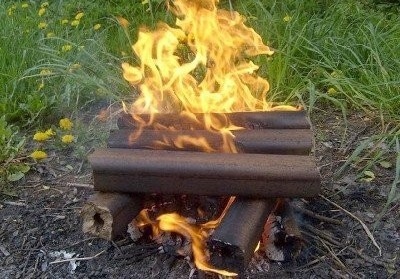Briquettes for heating: is it profitable in comparison with other types of fuel?
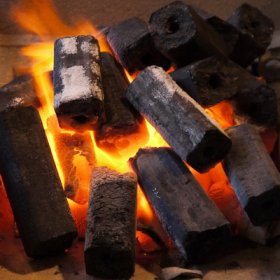
The appearance in the solid fuel industry of new types of combustible material poses a difficult choice for users. What to prefer: cheaper birch logs or more expensive briquettes for heating, dirty and inconvenient to use coal or environmentally friendly granules from biomaterial? Why are briquettes from industrial waste becoming popular and is it profitable to buy them for use in a summer cottage? Consider the characteristics of fuels and choose the most profitable option.
Content
Manufacturing technology and scope
After processing natural raw materials, a large amount of waste remains. For example, in the woodworking industry it is shavings, sawdust, wood chips. Each production tends to a non-waste operation scheme, so even the remnants of raw materials have long been learned to use for the manufacture of the right products, for example, particle board. With the rise in price of solid fuels, the waste began to be pressed into briquettes convenient for use and transportation - and they immediately became in demand.
The technology for manufacturing wood briquettes for heating is simple: the waste is crushed, pressed, and subjected to heat treatment. For bonding particles, a natural component of lignin or synthetic solutions is used. Lightly melt the surface to maintain shape.
To increase combustion efficiency, some species have through holes. Then, small-sized products are packed in film or paper bags, more protected briquettes are left unpacked. In this form, products are sold for private and industrial needs.
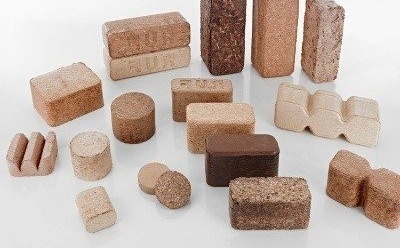
When purchasing briquettes at retail or, which is much more profitable, in bulk, pay attention to the shape and size - they must match your boiler, stove or barbecue
The heat transfer of the fuel is enough to be successfully used for heating completely different rooms, such as:
- production workshops, warehouses with an area of up to 200 m²;
- utility rooms, boiler rooms;
- private ownership: cottages, country houses, cottages;
- Russian baths, saunas.
Small briquettes and granules are easily placed in furnaces of any size; for solid-fuel boilers, euro-woods of increased length or diameter are provided. One example: 30-35 kg of fuel from sawdust is needed per day to heat a large warehouse hangar with an area of 180-200 m², that is, 3-3.5 standard ten-kilogram packages will be needed.
Light and compact briquettes are convenient for transportation in the trunk of a car, they burn beautifully in the open air, so lovers of outdoor recreation prefer to take them with them to make bonfires, barbecue or prepare dishes on the grill. For summer residents, briquetted products are a universal means - they have been successfully used for heating homes and for making fire on the site.
Classification of briquetted products
The division into groups takes into account various criteria: material of manufacture, form of products, degree of protection, degree of environmental cleanliness, even the type of packaging.Consider one of the common classifications - by type of manufacture and shape.
Most briquettes are products of a certain configuration:
- RUF - rounded bricks.
- Nestro - cylinders of various lengths.
- Pini-kay - elongated polyhedrons with a hole in the middle.
The first RUF squared products appeared in Germany. Powerful hydraulic presses operating under pressure up to 400 bar are used for their release. The cylindrical form is produced on machines with hydraulics or a shock-mechanical drive, some "barrels" have a radial hole.
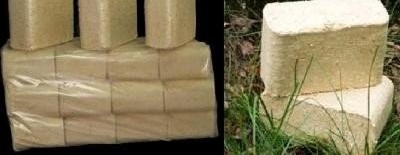
RUF briquettes are chosen for their compactness, low cost and ease of use. They continue to give off heat even when there is no open flame.
In addition to the standard mechanical pressing procedure under pressure up to 1100 bar, thermal firing is used for the production of pin-key tubes. It increases strength, moisture resistance, calorie content and prolongs the burning period. The products of the first two groups, on the contrary, are fragile and easily absorb moisture, therefore they are always packed in airtight containers that are convenient for transportation. Long cylinders and tubes (60-70 cm) can be easily divided into parts if desired.
The quality of the processing of fuel briquettes also affects their cost - a pin-key is more expensive than two other analogues. They can be recognized by the characteristic black or dark brown color of the outside. Material of manufacture and specifications are usually indicated on the packaging.
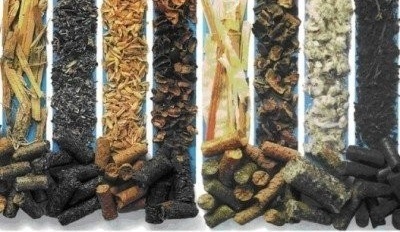
Along with fuel briquettes, pellets are used - small pellets. They have high heat dissipation due to their high carbon content and dense structure.
Fuel briquettes are classified as environmentally friendly fuels for several reasons:
- for production use exclusively waste to be disposed of - dust, chips, sawdust;
- when burning briquetted fuel, a minimum of carbon dioxide is emitted (for comparison, the combustion of natural gas increases the amount of carbon dioxide emitted by 10 times, coal - by 50 times);
- as a result of combustion, ash (not coal) is formed, which is suitable for feeding garden crops as nitrogen fertilizer.
Briquette heating of cottages and country houses is safe and effective.
However, the most convenient classification is recognized by the material of manufacture, that is, the remains of natural raw materials - agricultural biomass, coal dust, sawdust, peat chips, etc. We will dwell on it in more detail.
Types of briquettes by composition of raw materials
Consider the advantages of each type of fuel, so that it becomes clear which of them has a large heat transfer, and which is beneficial to purchase for stove or boiler heating.
Coal briquettes
Small briquettes in the form of black cylinders or tablets are made from coal screenings - waste from the coal industry. The screenings are further grinded, diluted with binders, pressed. Suitable for furnace furnaces and barbecues. It is popular with owners of small cafes, bars, road restaurants.
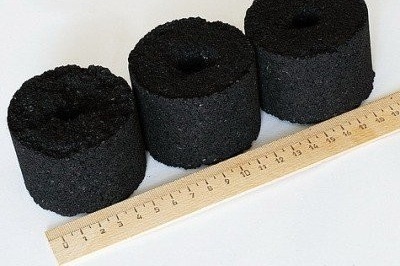
The technology for the production of coal briquettes preserves the color and physical properties of the material, however, the pressed products do not leave marks and do not stain hands and clothes like coal
The processed raw materials emit much less smoke and carbon monoxide than its base - natural coal. It can be used in private households, but more often coal products are purchased by enterprises with boiler equipment.
The burning time in the furnace is 6-7 hours, if the air supply system is set up to 10 hours, that is, it is possible to maintain a constant temperature for a long time. Heat transfer - 5200 f / cal. The amount of ash compared to other briquetted products is large - 28%, but this is much less than the amount of slag in conventional coal heating.
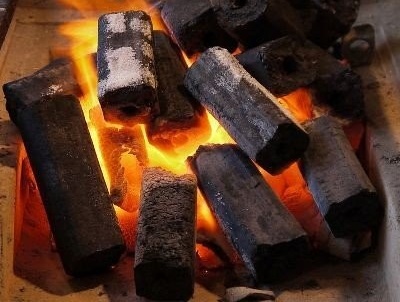
The amount of combustion waste of coal briquettes depends entirely on the components that make up their composition: coal chips, anthracites, brown coal, coke and semi-coke particles
Particularly popular are coal briquettes for heating in the regions where black gold is mined. There is no need to overpay for transportation, so fuel prices are affordable.
Wood briquettes
Thanks to lignin, wood waste briquettes become durable and convenient for transportation. Almost any species is suitable for manufacturing - birch, spruce, oak, pine. Their heat transfer is less than that of fuel from husks of sunflower and coal products.
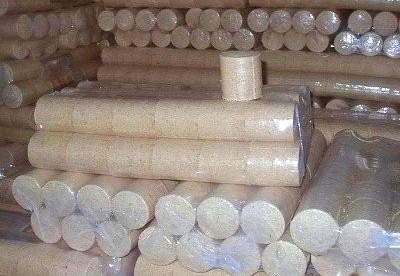
If you first decided to purchase wood briquettes, remember that their number is calculated in kilograms, not cubic meters, accepted for counting firewood
Despite the change in the structure of wood during the manufacturing process, after burning, briquettes, like logs, leave coals. Due to this property, they are ideal for cooking meat and fish dishes during a picnic. They have all the positive qualities of organic products, moreover, they are universal and economical. Among the people, briquettes made of substandard wood are often called "euro-woods".
The level of heat transfer is great due to its high density - 1240 kg / m³, while ordinary firewood can have a density much lower than 1000 kg / m³ - for example, 150 kg / m³. After burning logs, about 5% of the total ash remains, while briquettes leave only 1%.
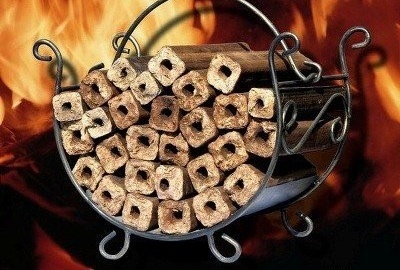
The heat transfer of wood briquettes is much higher than that of ordinary firewood: in the process of burning, the briquette emits 4,500 kcal / kg, while logs - no more than 3,000 kcal / kg
Pressed wood is valued for minimal smoke and no sparking. The burning period is 4 hours. The cost of pressed wood fuel of the Roof type is 6200-6800 rubles / ton, a pin-key is 9000-9500 rubles / ton.
Peat briquettes
The excellent combustible properties of fuel have been known for a long time (heat transfer - up to 5700 kcal / kg), but few people know about its disadvantages. Many refuse peat briquettes for heating due to waste. After burning through, a lot of ash remains, which, however, is in the hands of summer residents - it is good to fertilize plantings in the garden and in it. Peat products contain phosphorus and lime.
Another minus is smoke, hazardous to health. Peat burns for about 10 hours, which is convenient for night heating in private homes, but under one condition - one hundred percent serviceability of the stove.
It is not worth using peat products regularly, but for temporary cottage use it is quite acceptable. Briquettes should be handled with care and not left near open flames - peat dust will ignite instantly and can cause a serious fire.
Husk briquettes
A real breakthrough in the fuel sector was the production of briquettes from biological waste - husks of sunflower, ordinary straw, husks of rice or buckwheat, screenings of wheat or oats. Everything that was previously disposed of was beneficial. During combustion, sunflower raw materials can be recognized by a pleasant specific smell.
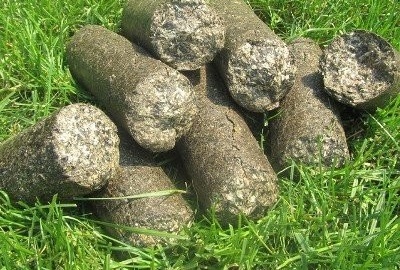
Sunflower husk briquettes have low humidity and high calorific value: 100 kg of pressed vegetable fuel can easily replace 150-200 kg of firewood
High heat transfer of vegetable fuel occurs due to the content of oils in the product, it is equal to the heat transfer of the coal analogue - 5200 kcal / kg. A large percentage of waste does not suit many people - 2.8-4.5% of the ash remains, but low cost is a decisive factor, and sunflower husk products are used with great pleasure.
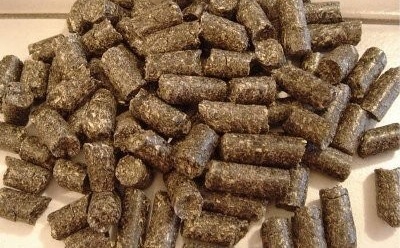
Granules from the husks of sunflower are usually sold in bulk. They have the lowest cost in bulk purchases; retail is a bit more expensive
If you want a cheap, environmentally friendly fuel - buy briquettes and pellets from husk.
The secret to the popularity of pressed fuel
If we summarize all the positive qualities of various types of briquettes, we can say that their use is much more rational and more productive than heating rooms with traditional fuel - coal or wood. The only negative that keeps many from buying is the higher cost, but the unique set of useful qualities fully justifies it:
- safety - the amount of harmful smoke is minimal, the occurrence of sparks is practically excluded;
- high heat transfer, respectively, increased heat volume;
- low humidity, which affects the efficiency of combustion;
- combustion quality - the process proceeds long and evenly;
- compactness, convenient for storage and transportation;
- the possibility of long-term storage and purchase "in reserve" - pressed fuel is sold in sealed packages.
Neatly designed, clean briquettes near the fireplace or stove are a kind of sign of a comfortable life. They do not stain hands and the floor, like coal, do not leave garbage like firewood. The absence of smoke and a lot of ash complements the picture of well-being.
Briquetted products are chosen by people who prefer order, rational use and environmental cleanliness.
